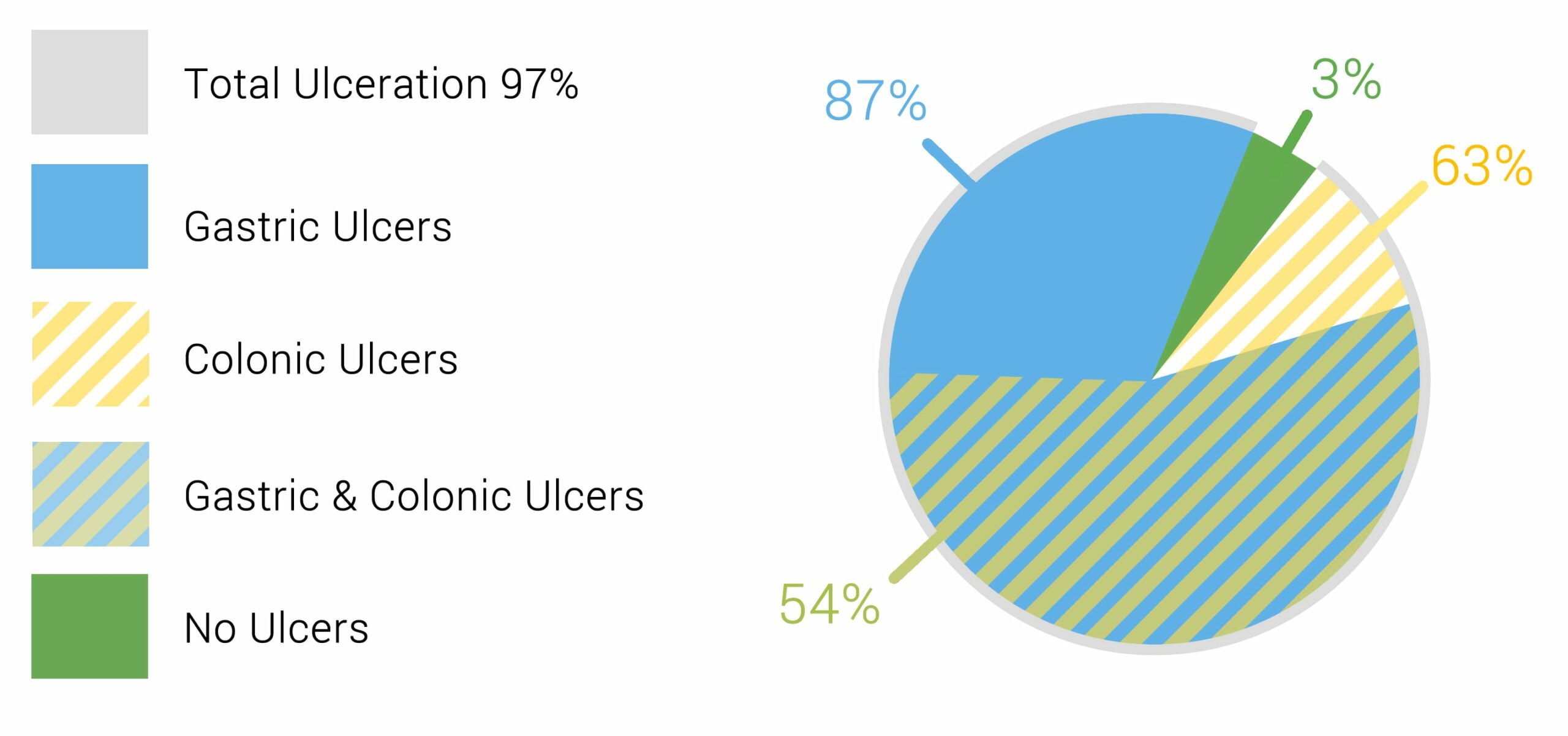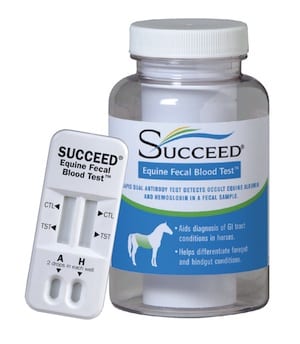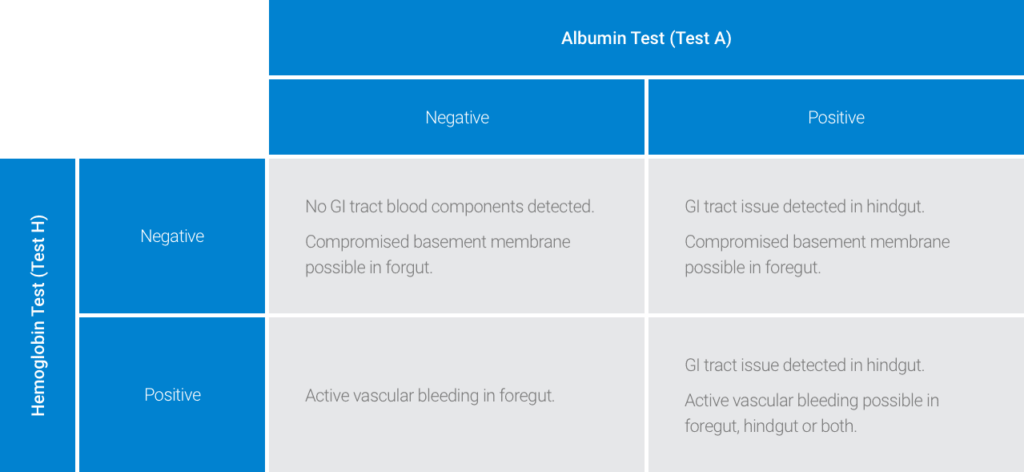When it comes to the gastrointestinal health of our patients, equine veterinarians are highly aware of the widespread nature of gastric ulceration, especially for horses used in competition and professional settings. We also deal with colic as the top cause of medical death in horses, and we’re called upon regularly to diagnose and treat bacterial imbalances, diarrhea and other GI upsets. Considering those are specifically hindgut issues, horses are hindgut fermenters, and the hindgut makes up the majority of the GI tract, we ought to be concerned.
Should we be giving more attention to the hindgut, and is there a greater role that the hindgut plays in equine GI upset?
Unfortunately, the tools available to diagnose hindgut issues in horses are limited. Here’s why you need to be paying more attention to hindgut health, why early detection matters, and the options you have for more accurate GI diagnosis.
The Need to Address Widespread Issues of the Hindgut
Ongoing research shows that digestive problems are widespread. It is likely that horses in your practice are suffering from significant GI problems that are going undetected.
In fact, a study published in the Journal of Equine Veterinary Science by Dr. Franklin Pellegrini found that only three percent of the sampled horses showed no ulcer issues at all. Repeated studies in abattoirs over more than a decade have continued to show that colonic ulcers exist in a high percentage of horses.

Hindgut Pathologies Affect Health and Performance
Hindgut pathologies affect the horse in a multitude of ways. Of course, there are the clear clinical signs of digestive upset such as diarrhea, weight loss, poor condition, inappetance, and chronic colic. In addition to those, and sometimes even in their absence, the horse may also be negatively affected in its energy, recovery, soundness, temperament, behavior and performance ability. None of these symptoms are specific though, and are just as likely if not more to arise from a hindgut problem than from the stomach.
Evan in an instance where the horse is well trained and handled, the level of discomfort caused by a hindgut condition can hinder the horse from performing at its maximum ability. This, plus a decrease in healthy digestive function and nutrition, can affect the horse’s trainability and willingness, and may even cause an uncomfortable horse to become dangerous. These are all factors which greatly affect the client; including training, performance results and the increased costs associated with diagnosis and treatment.
The Difficulty with Diagnosing Hindgut Conditions
Those behavior and performance issues may often be the first sign that a digestive problem is brewing in an equine patient. Unfortunately, clients and their veterinarians don’t often consider GI health until the classic clinical symptoms of a gut pathology arise. At that point, the horse’s health has likely deteriorated further and requires greater intervention to put right.
This delayed intervention, along with a lack of diagnostic options to accurately identify hindgut conditions, can spell negative outcomes for the horse.
Importance of Early Detection and Accurate Diagnosis
Early detection and accurate diagnosis are the two keys to add new layers of GI coverage in how you practice. The earlier GI conditions are accurately diagnosed, the faster you can provide a targeted, effective treatment and get the horse’s health back on track.
To be able to accurately identify an appropriate treatment response and determine the most effective management, it is necessary to differentiate whether the problem is in the foregut, hindgut or both. Not being able to accurately diagnose early and get ahead of the issue only increases the time, cost, and risk involved in treatment.
Common Diagnostic Options and Their Limitations
The current common diagnostic modalities for GI health are limited and do not provide an accurate and timely diagnosis that supports effective treatment before the condition turns serious.
- Scoping – While scoping is an adequate approach as far as showing a clear picture of the stomach, it is limited to showing the stomach only, a mere 10 percent of the horse’s GI tract. In addition, scoping requires fasting and sedation, which is costly, invasive, and highly stressful for the horse.
- Ultrasounds – Ultrasounds are another diagnostic option, allowing you to confirm wall thickness and fluid content. It only shows limited visuals, though, so you are not able to capture the full GI tract. And it also requires sedation and fasting.
- Rectal Palpation – Rectal palpation is a relatively easy option, yet the actual benefit is limited for diagnostic purposes as you can only reach so far and it is strictly based on tactile feel.
- Symptomatology – Diagnosing primarily on observation may be a common method for detecting GI issues, but it does not provide enough information for a confident conclusion and may arise too late.
The Need for a Better Diagnostic Method
None of these methods illuminate the specific pathology, the severity of the injury to the gut, or if the problem is in the hindgut or foregut. Because the structure and function of the fore- and hindguts are very different, they require targeted, localized treatment in order to be effective.
Accurate diagnosis is critical for restoring health. Equine veterinarians need a more reliable diagnostic method to detect the issues arising in the hindgut. Ideally, you need a method that helps target the location of the issue, is affordable, non-invasive and causes minimal or no stress to the horse. To be able to make the most accurate diagnosis, you need to be equipped with the right tools.
SUCCEED Equine Fecal Blood Test

Improving your GI diagnostic capabilities is key in preventing potential digestive conditions from going unrecognized and unresolved in your practice.
The SUCCEED Equine Fecal Blood Test is an affordable, non-invasive, rapid stall-side diagnostic tool specific for equine GI tract disorders. The FBT uses antibodies to detect two equine-specific blood components in a fresh fecal sample, giving you a starting point to begin the diagnostic process by ruling in digestive disease right away. Perhaps most importantly, it accurately detects inflammation or lesions in a horse’s hindgut, which previously could only be seen definitively during surgery or at postmortem.
The FBT helps to differentiate foregut from hindgut by detecting albumin and hemoglobin in a fresh fecal sample. Test A detects the blood component albumin, which indicates a hindgut issue. Test H detects hemoglobin, which may originate from anywhere in the GI tract.

Each FBT includes one complete test for one horse, including:
- A plastic container (for collecting a sample)
- Dual test cassette
- Sample pipette
- Polyethylene glove
- Instruction sheet
Get more detailed instructions here.
This simple test helps you identify pathologies that could otherwise go undetected, helping you to catch the issues early and regularly monitor the GI health of the horse.
Request a Free Trial of the FBT
Equine veterinarians caring for performance horses are eligible for a free trial of the SUCCEED FBT. Our team would love to talk with you about the FBT and set you up with a sample to try.
Next Step After Diagnosis: Ongoing Management
Common treatment approaches do little to keep hindgut issues from recurring, as they only mask the problem. We take a fresh, nutritional approach by moving away from symptom treatment to health management, with SUCCEED Veterinary Formula and SUCCEED Digestive Conditioning Program. We encourage you to utilize our free, two-part webinar series for further information on ongoing GI health diagnostics and management with SUCCEED.



